Key takeaways:
- Post-conflict recovery requires addressing emotional healing alongside physical reconstruction, emphasizing community support and storytelling as vital therapeutic tools.
- Peer motivation significantly enhances the recovery journey, fostering feelings of belonging and encouraging individuals to confront their challenges collectively.
- Creating a supportive environment involves trust-building, recognizing small victories, and establishing clear communication guidelines that promote empathy and understanding.
- Setting collective goals can unify individual aspirations, fostering a sense of accountability and purpose while enhancing engagement within the community.
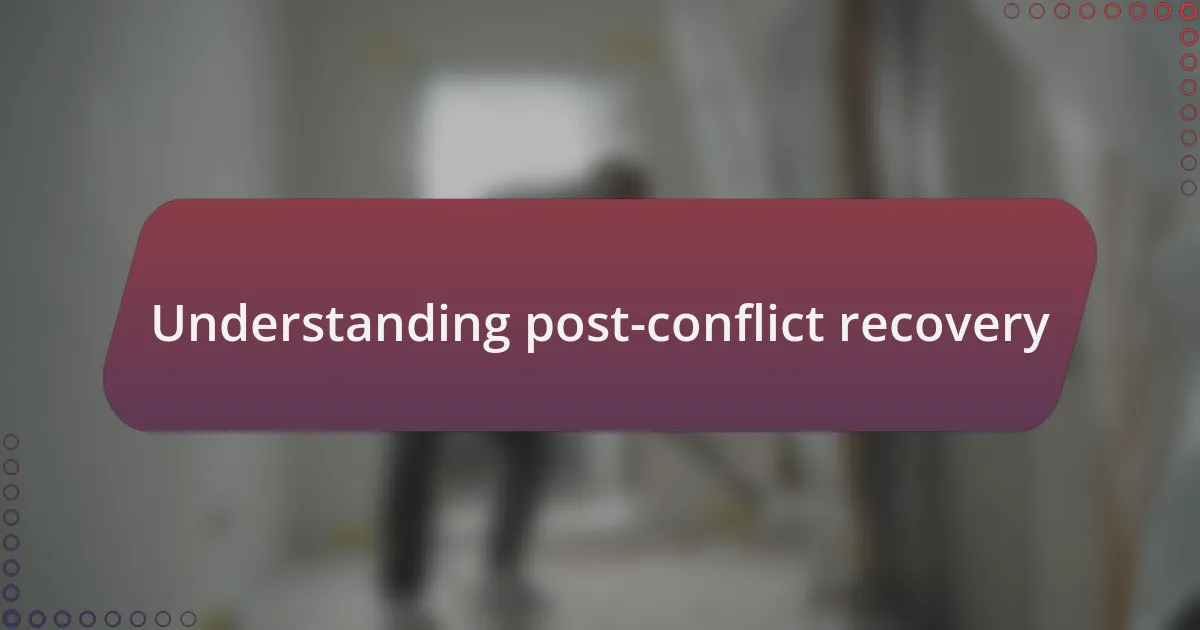
Understanding post-conflict recovery
Post-conflict recovery is not just about rebuilding physical structures; it’s also about healing the emotional scars that conflict leaves behind. I remember speaking with a friend who had witnessed the aftermath of war in their community. They described how the silence following the chaos was often more painful than the conflict itself, leading me to wonder: how do we truly support healing in such a context?
In my experience, recovery involves a complex interplay of community, mental health support, and economic opportunity. Consider the role of storytelling; sharing one’s experiences can be a profound therapeutic tool. I once facilitated a workshop where participants openly exchanged their stories, and it struck me how this simple act of listening created an immediate bond, helping them feel less isolated in their struggles.
It’s crucial to understand that recovery is not a linear path. I often reflect on how it can involve setbacks and progress that are hard to gauge. I have engaged with many individuals who have taken multiple steps forward only to experience moments of doubt; this brings to mind the question: how can we create systems that support resilience amidst such unpredictability? By fostering open conversations and building supportive environments, we can help pave the way for stronger, more resilient communities in the aftermath of conflict.
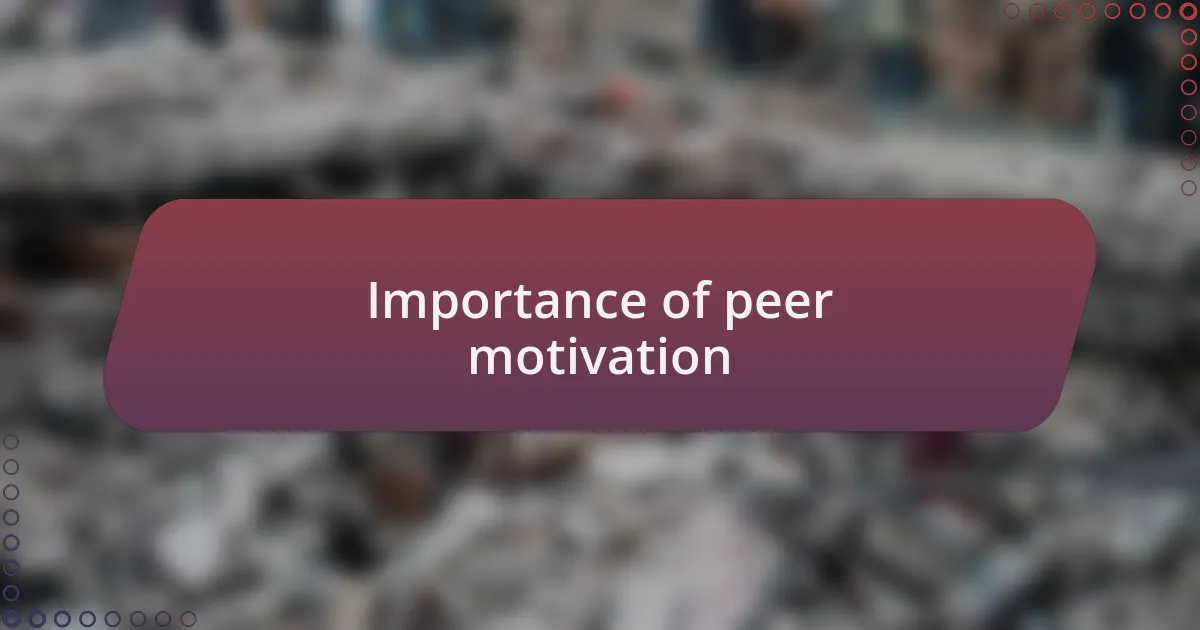
Importance of peer motivation
Peer motivation plays a vital role in post-conflict recovery, as the journey towards healing often feels daunting when faced alone. I recall a time when I joined a support group focused on collective healing, and the encouragement I received from my peers made a significant difference. Their shared stories of resilience motivated me to confront my challenges head-on, reminding me that I was not alone in my struggle.
The emotional bonds formed in these environments create a sense of belonging that is crucial for recovery. I’ve seen firsthand how a simple affirmation from a peer, like “You can get through this,” can ignite a spark of hope in someone who feels lost. It’s remarkable how these small gestures can transform someone’s outlook, fostering an atmosphere where individuals feel empowered to share their vulnerabilities and grow together.
Moreover, peer motivation often leads to a ripple effect in the community. When I observed someone in my group take significant strides toward their own recovery, it inspired others to do the same. This dynamic raises an important question: how can we cultivate these motivating environments consistently? By actively engaging in discussions that affirm and uplift each other, we can strengthen our collective resolve, demonstrating that we all play a crucial role in each other’s healing journeys.
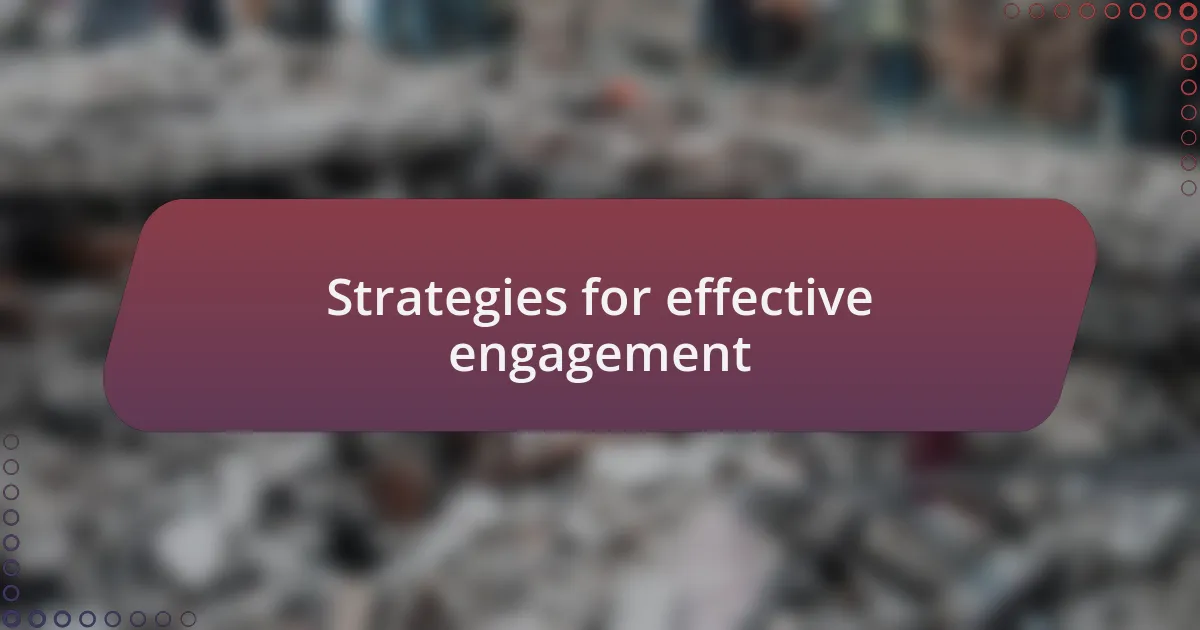
Strategies for effective engagement
One effective strategy for enhancing engagement in a post-conflict recovery website is creating an environment where stories can be openly shared. I remember initiating a storytelling session in my support group, where each person shared a personal narrative of their recovery journey. The vulnerability displayed during those sessions not only fostered deep connections but also invited newcomers to participate, breaking down the barriers of fear and isolation.
Encouraging peer-led discussions is another impactful approach. I’ve found that when peers take the lead, the conversations become more relatable and genuine. During a recent online meeting, a fellow member facilitated a discussion on coping mechanisms. Their lived experience resonated with many of us, prompting heartfelt exchanges and questions that deepened our collective understanding. How often do we overlook the power of shared experiences in cultivating a supportive atmosphere?
Lastly, incorporating regular check-ins can significantly enhance engagement. By asking for feedback and personal insights, group members feel valued and heard. I once sent out a simple survey to my peers, asking what topics they felt needed more attention, and the responses transformed our subsequent meetings. It reminded me of how crucial it is to listen actively to one another. This strategy not only elevates individual voices but also strengthens the community’s bond, making everyone feel invested in each other’s healing.
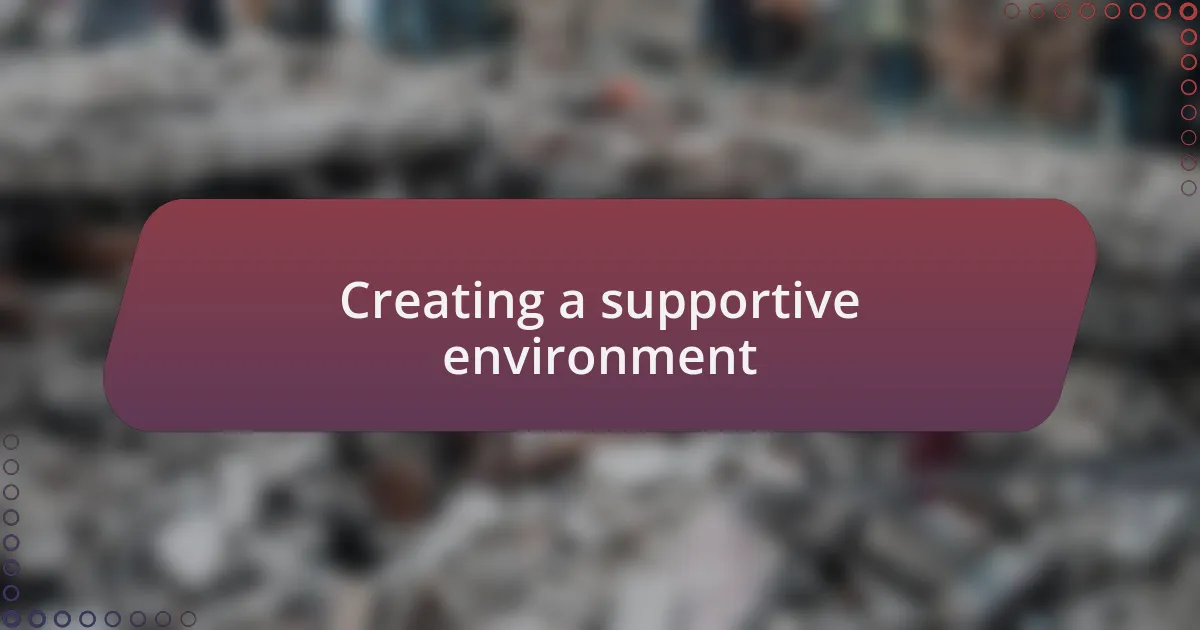
Creating a supportive environment
Creating a supportive environment revolves around fostering trust among community members. I remember when I organized small group discussions, ensuring each session provided a safe space for honest expression. The first time we sat in a circle sharing our fears and hopes, it struck me how quickly the atmosphere shifted; laughter mixed with tears created a bond so profound that it encouraged quieter members to speak up.
Another way to cultivate support is by recognizing and celebrating small victories. When someone in our group achieved a personal goal, no matter how minor it seemed, we made it a point to acknowledge it. I vividly recall the joy in a member’s eyes when we cheered for her completion of a week without flashbacks. How powerful is it to be uplifted by those who truly understand your journey?
Moreover, it’s essential to establish clear guidelines that promote respect and empathy. I once facilitated a workshop where we developed a collective agreement on how to communicate, avoiding judgment and fostering understanding. This experience showed me the importance of setting boundaries; it creates not just safety but also encourages open dialogues. Isn’t it incredible how a few simple rules can transform interactions into meaningful exchanges of support?

Sharing personal experiences
Sharing personal experiences can be a powerful catalyst for connection. I recall a time when I shared my own story of struggle and resilience during one of our meetings. The moment I opened up about my darkest days, I could see the flicker of recognition in the eyes of others. It made me realize how vulnerability can transform a room; suddenly we were all united by the weight of our experiences, and there was an unspoken understanding that none of us were alone in our journeys.
I also remember a member who hesitated to share her own experiences, feeling as though they were too trivial compared to others. I encouraged her to speak, reminding her that every story holds value, regardless of its scale. When she finally found her voice, the sense of relief on her face was palpable. It struck me how sharing these narratives can validate feelings that might otherwise remain hidden, fostering a deeper connection within our group. Have you ever felt that rush of catharsis when you finally articulate something deeply personal?
In my experience, creating spaces where stories flow freely can spark profound insights. One evening, after a particularly moving exchange, several members expressed gratitude for the courage displayed by one individual to share her traumatic past. It was a moment that illustrated how our collective storytelling not only promotes healing but also builds a bridge of empathy among us. Sharing experiences encourages the kind of dialogue that breeds understanding—don’t you wish more communities could embrace such openness?
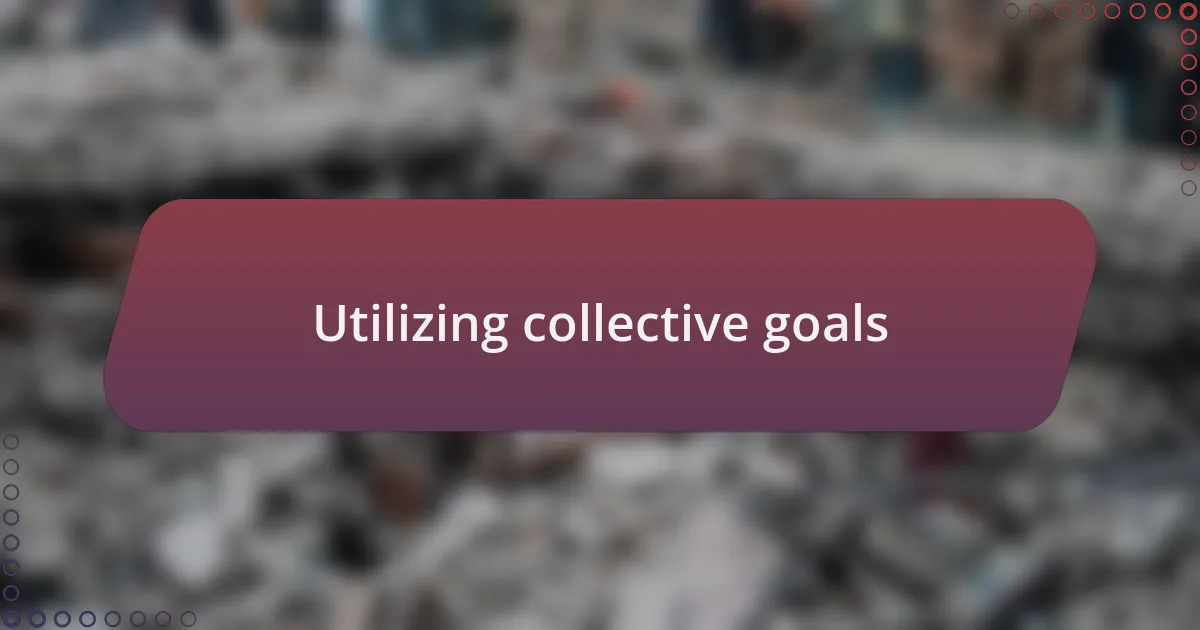
Utilizing collective goals
Setting a collective goal can transform individual aspirations into a shared mission. I remember when we collectively decided to focus our efforts on raising awareness about our website’s resources for trauma recovery. Each member contributed their own ideas and skills, which really brought us closer together. Don’t you find that when everyone is working toward the same objective, there’s a natural synergy that drives progress?
During one meeting, we brainstormed ways to amplify our online presence, and the energy in the room was electric. I noticed how some participants, who often stayed silent, suddenly lit up with inspiration. It was as if the collective goal had unwrapped hidden potential. Watching my peers take ownership not only boosted their confidence but also solidified our sense of community. Could there be a better way to foster engagement than showing that everyone’s contribution matters?
Ultimately, when we set clear, shared objectives, we create a sense of accountability and commitment. I recall the day we reached our milestone of articles published on the website; the satisfaction on everyone’s faces was priceless. It made me realize how embracing collective goals does more than just drive engagement—it cultivates a sense of belonging and purpose that can propel us through even the most difficult times. Have you ever experienced such a pivotal moment when teamwork really clicked?
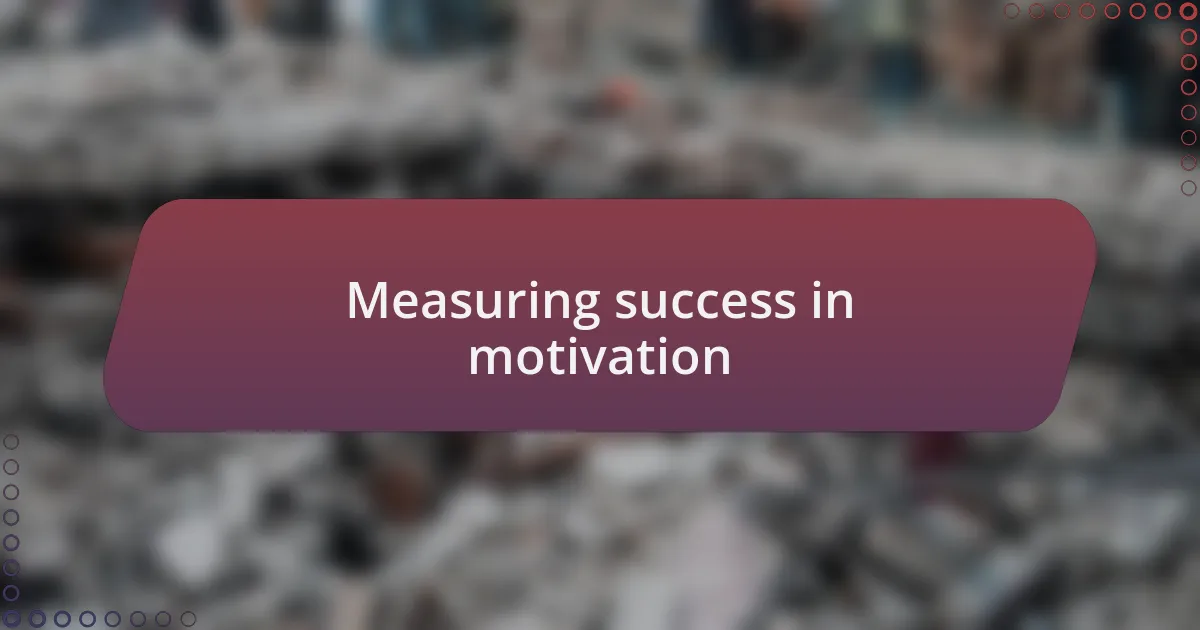
Measuring success in motivation
To gauge the effectiveness of our motivational strategies, I found it essential to track specific metrics, such as participation rates and engagement levels. For instance, I recall a particular month when we launched a series of interactive webinars; participation doubled from our previous sessions. This surge not only reflected increased interest but also validated our collective efforts in drawing peers into meaningful discussions. Isn’t it fascinating how numbers can tell such an inspiring story?
Another way I measured success was through feedback surveys after events. The insights gained from my peers were invaluable. One comment stood out: “I felt empowered to share my experiences.” That simple feedback reinforced my belief in the impact of our initiatives. It reminded me that the true measure of success isn’t just in numbers but in the personal transformations we witness along the way. How often do we stop to appreciate the ripple effect of our efforts?
Lastly, I kept an eye on the interactions within our online community. One day, I observed several members supporting each other in discussions about their recovery journeys. These exchanges were both heartfelt and candid. It struck me that the genuine connections formed during this process were a true testament to our success in motivating one another. Have you noticed how authentic relationships can become the bedrock of engagement in any community?